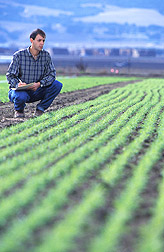This page has been archived and is being provided for reference purposes only. The page is no longer being updated, and therefore, links on the page may be invalid.
| Hassle-Free Harvesting Ahead for Baby GreensBy Marcia WoodMarch 13, 2002 Baby salad mixes offer an array of crisp, bite-sized greens. But harvesting the tiny plants used for these colorful medleys can pose a problem for conventional and organic growers. That's according to Eric B. Brennan, a research horticulturist with the Agricultural Research Service in Salinas, Calif. A mechanical harvester clips off these individual greens at the surface of the field. However, that surface may be littered with pieces of stems, leaves or roots left over from what's known as a cover crop. Grown the previous season in that same field, the cover crop is plowed under to enrich the soil. Inevitably, the harvester picks up some cover crop leftovers. That's because they are proportionately larger than the small greens. Getting rid of the residue thus becomes a chore in the packinghouse where the baby greens are washed, sorted and bagged for the grocer. Cover crop leftovers aren't a problem when harvesting full-sized greens. Those greens are hand picked and the residue is proportionately smaller, meaning that any debris is more likely to remain in the field. In a new study at the ARS Crop Improvement and Protection Research Unit in Salinas, Brennan is exploring a potential solution to this unique problem. The approach? Grow a somewhat smaller cover crop plant that would decompose more rapidly. To produce these smaller cover crop plants, Brennan is increasing the competition between the individual plants. He is doing that by doubling the recommended seeding rate of several cover crops, such as oats and rye. Brennan expects to have preliminary results of this study by May 2002. Baby salad greens are one of the fastest growing products of organic farmers in the Salinas Valley and surrounding counties, according to Brennan. For a farm to be certified as organic, its products must be grown in accordance with organic standards. The findings from Brennan's study will help conventional and organic farmers alike because both use cover crops. ARS is the US Department of Agriculture's chief scientific research agency. |


